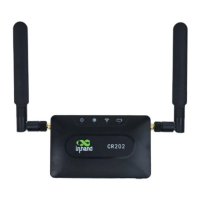
Do you have a question about the InHand CR202 and is the answer not in the manual?
| Brand | InHand |
|---|---|
| Model | CR202 |
| Category | Wireless Router |
| Language | English |
Provides a general overview of the CR202 portable 4G router's capabilities and features.
Lists the necessary precautions and requirements before installing the router.
Covers the physical installation steps for the router.
Configure system settings like language, hostname, time, and admin access.
Configure network interfaces and connectivity settings.
Configure various network services like DHCP, DNS, and DDNS.
Configure firewall rules for network security.
Configure basic firewall rules and policies.
Configure Quality of Service (QoS) for bandwidth management.
Provides a general overview of the CR202 portable 4G router's capabilities and features.
Details the physical ports and indicators on the router's panel.
Explains the meaning of different LED lights and signal indicators.
Instructions on how to restore the router to its factory default settings.
Lists the necessary precautions and requirements before installing the router.
Covers the physical installation steps for the router.
Step-by-step guide to installing the SIM or UIM card.
Instructions for properly connecting and installing the antenna.
Details on power connection methods, including battery and type-C.
Guide to logging into the router's web-based management interface.
Configure system settings like language, hostname, time, and admin access.
Configure language and hostname for the router's web interface.
Set the router's system time, time zone, and NTP synchronization.
Manage user access methods (HTTP, HTTPS, Telnet, SSHD) and credentials.
Configure remote logging and view system logs.
Backup, import, and restore router configuration settings.
Set scheduled tasks, such as automatic system reboots.
Process for upgrading the router's firmware.
Configure network interfaces and connectivity settings.
Configure cellular network connection and PPP dial-up settings.
Configure the port mode as WAN or LAN.
Configure the LAN interface for network connectivity.
Set the router's WLAN mode (AP or STA).
Configure WLAN settings for Access Point mode.
Configure WLAN settings for Station (Client) mode.
Configure IP Passthrough for downstream devices.
Configure various network services like DHCP, DNS, and DDNS.
Configure DHCP server settings for IP address allocation.
Configure Domain Name System (DNS) settings.
Configure firewall rules for network security.
Control data access to the router based on protocol, address, and port.
Control data access to the router based on protocol, address, and port.
Set firewall rules to block access to specific URLs.
Configure port mapping to allow external access to internal hosts.
Configure MAC-IP binding for access control to the outer net.
Configure MAC-IP binding for access control to the outer net.
Configure Quality of Service (QoS) for bandwidth management.
Perform Ping tests to check network connectivity.
Perform Traceroute to diagnose network routing issues.
Conduct a link speed test for network performance.
Configure Samba client function for file sharing.
View system status, including model, serial number, and uptime.
View modem status, signal level, and IMEI/IMSI information.
View traffic statistics for received and transmitted data.
View and manage system alarms and their classification.
View WLAN connection status and information.
View status of WAN, Dialup, and LAN network connections.
Check connection status between router and Device Manager.
View the router's active route table.
View system logs, clear logs, and download log files.
Check third-party software used in the router system.